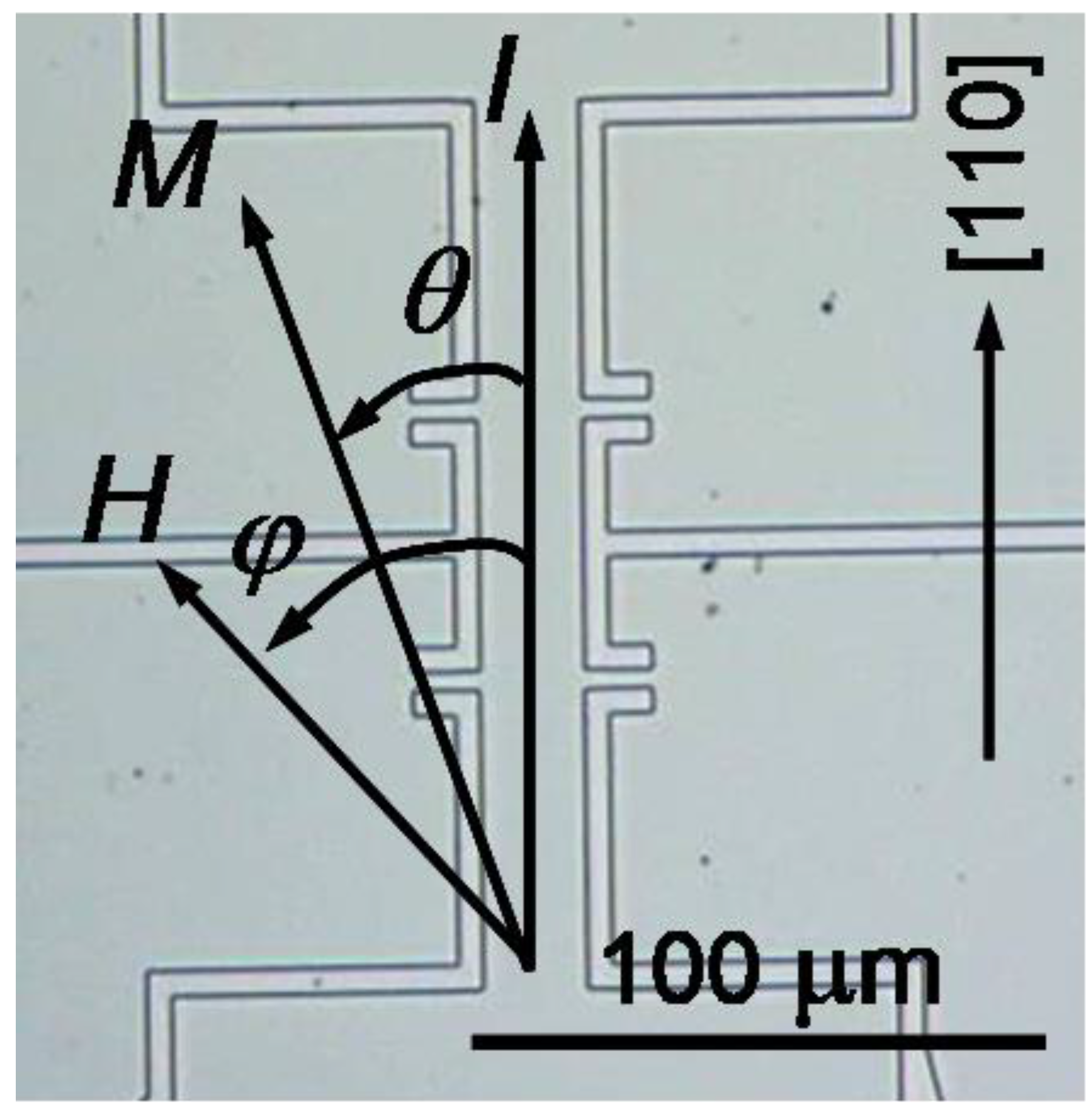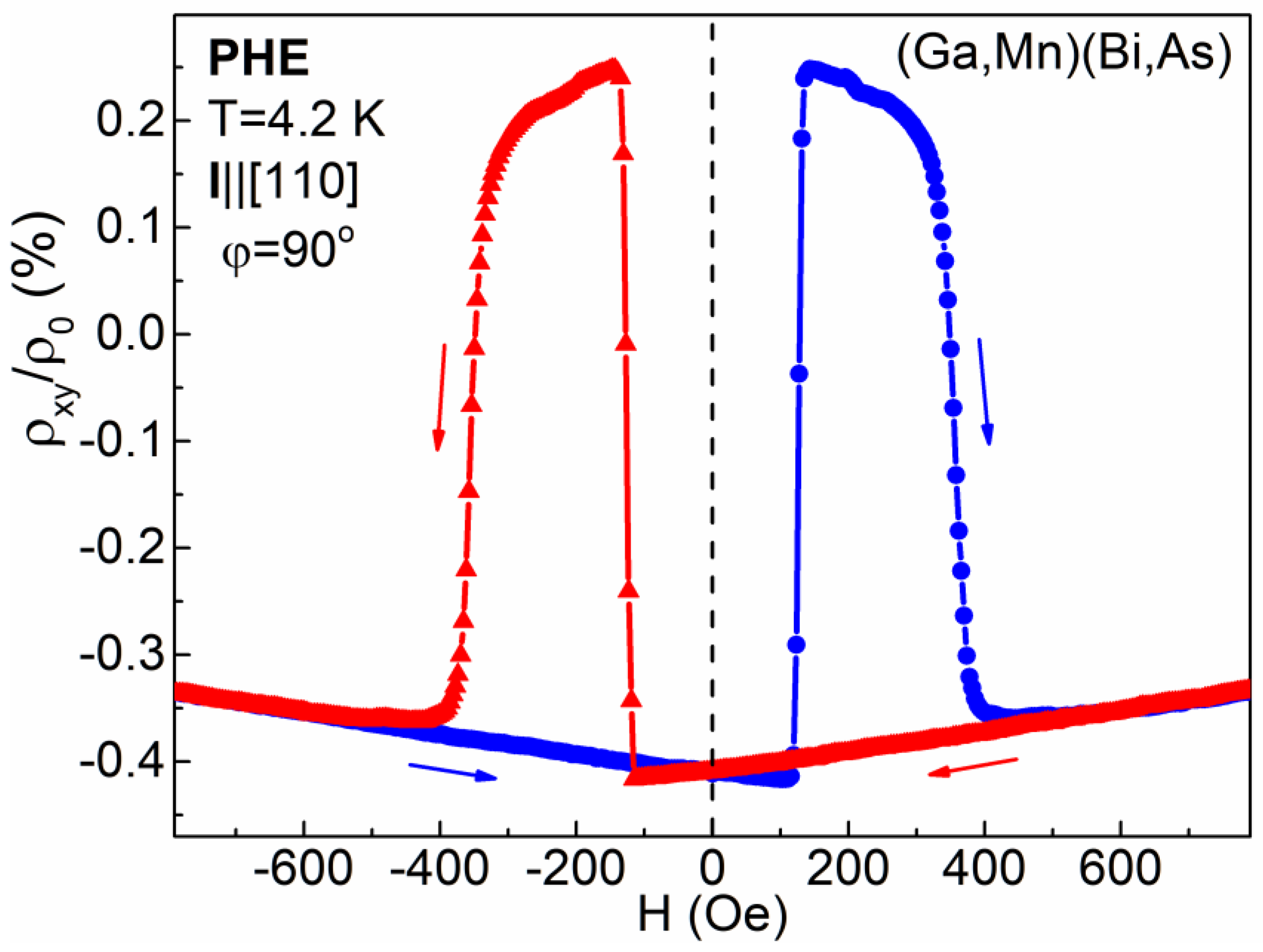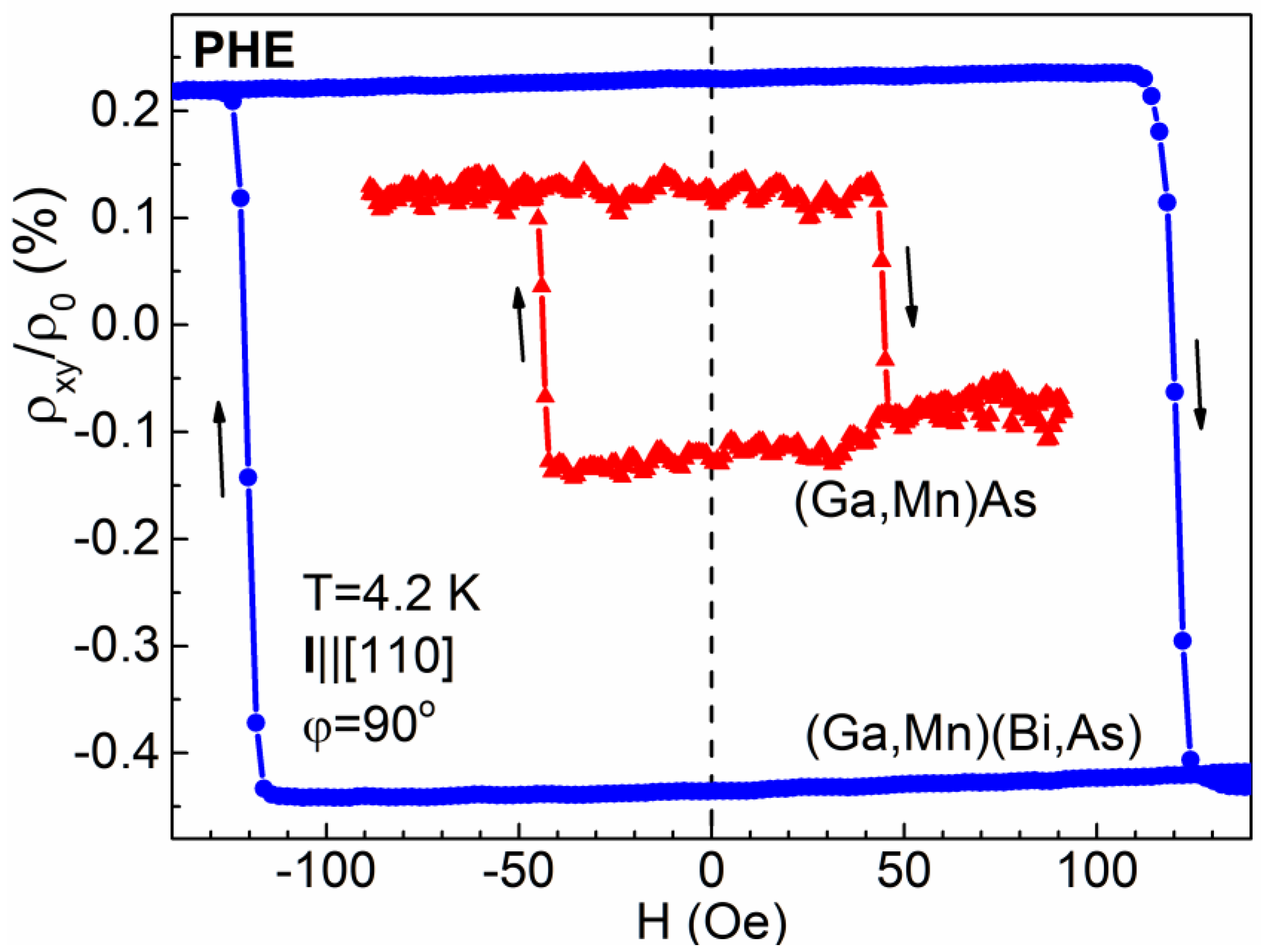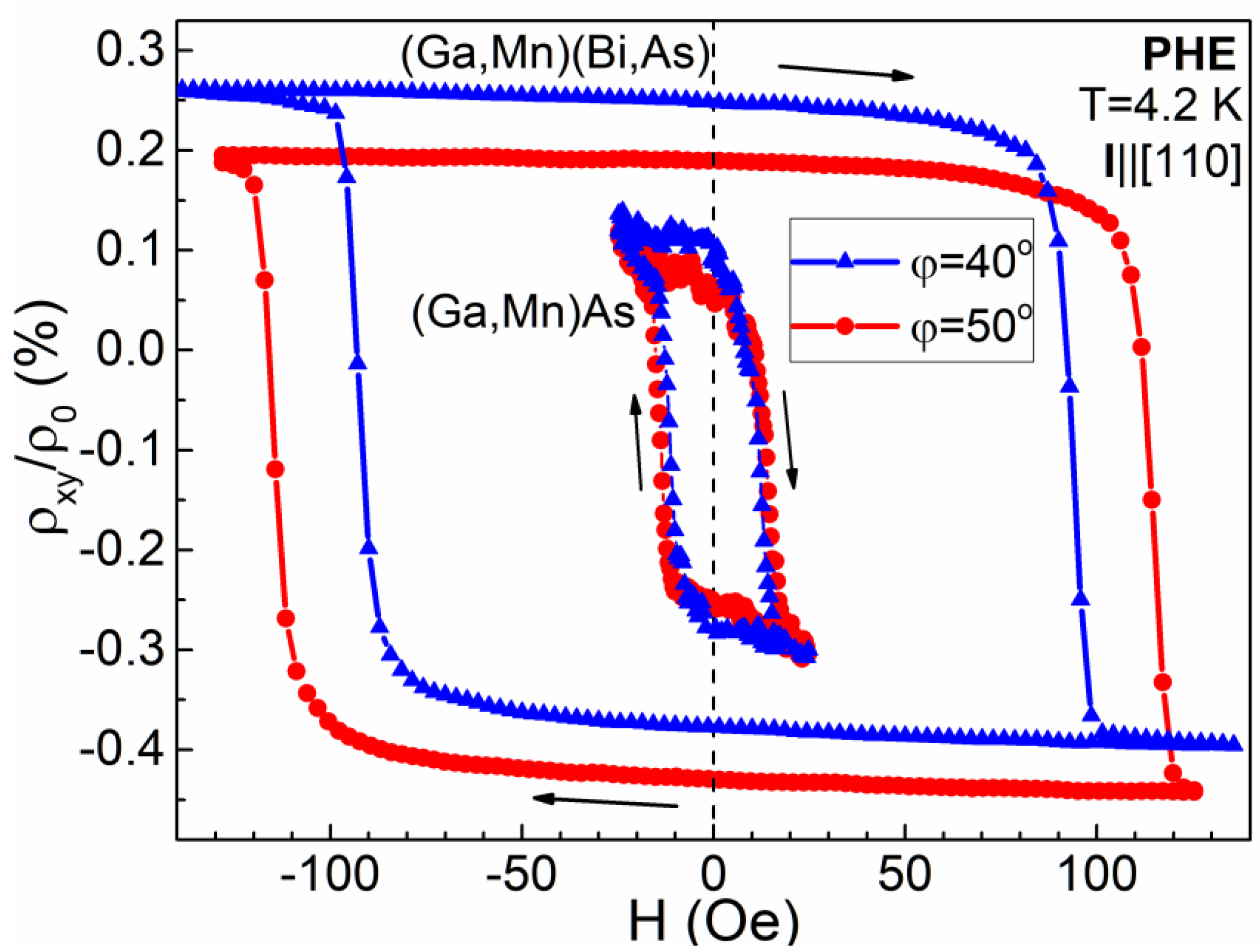Tunable Planar Hall Effect in (Ga,Mn)(Bi,As) Epitaxial Layers
Abstract
1. Introduction
2. Materials and Methods
3. Results and Discussion
4. Conclusions
Author Contributions
Funding
Institutional Review Board Statement
Informed Consent Statement
Data Availability Statement
Conflicts of Interest
References
- Yastrubchak, O.; Sadowski, J.; Gluba, L.; Domagala, J.Z.; Rawski, M.; Żuk, J.; Kulik, M.; Andrearczyk, T.; Wosinski, T. Ferromagnetism and the electronic band structure in (Ga, Mn)(Bi, As) epitaxial layers. Appl. Phys. Lett. 2014, 105, 072402. [Google Scholar] [CrossRef]
- Levchenko, K.; Prokscha, T.; Sadowski, J.; Radelytskyi, I.; Jakiela, R.; Trzyna, M.; Andrearczyk, T.; Figielski, T.; Wosinski, T. Evidence for the homogeneous ferromagnetic phase in (Ga,Mn)(Bi,As) epitaxial layers from muon spin relaxation spectroscopy. Sci. Rep. 2019, 9, 3394. [Google Scholar] [CrossRef]
- Dietl, T.; Ohno, H. Dilute ferromagnetic semiconductors: Physics and spintronic structures. Rev. Mod. Phys. 2014, 86, 187–251. [Google Scholar] [CrossRef]
- Fluegel, B.; Francoeur, S.; Mascarenhas, A.; Tixier, S.; Young, E.C.; Tiedje, T. Giant spin-orbit bowing in GaAs1-xBix. Phys. Rev. Lett. 2006, 97, 067205. [Google Scholar] [CrossRef]
- Usman, M.; Broderick, C.A.; Batool, Z.; Hild, K.; Hosea, T.J.C.; Sweeney, S.J.; O’Reilly, E.P. Impact of alloy disorder on the band structure of compressively strained GaBixAs1-x. Phys. Rev. B 2013, 87, 115104. [Google Scholar] [CrossRef]
- Yastrubchak, O.; Zuk, J.; Krzyzanowska, H.; Domagala, J.Z.; Andrearczyk, T.; Sadowski, J.; Wosinski, T. Photoreflectance study of the fundamental optical properties of (Ga,Mn)As epitaxial films. Phys. Rev. B 2011, 83, 245201. [Google Scholar] [CrossRef]
- Levchenko, K.; Andrearczyk, T.; Domagala, J.Z.; Sadowski, J.; Kowalczyk, L.; Szot, M.; Kuna, R.; Figielski, T.; Wosinski, T. Novel quaternary dilute magnetic semiconductor (Ga,Mn)(Bi,As): Magnetic and magneto-transport investigations. J. Supercond. Nov. Magn. 2017, 30, 825–829. [Google Scholar] [CrossRef]
- Andrearczyk, T.; Levchenko, K.; Sadowski, J.; Domagala, J.Z.; Kaleta, A.; Dłużewski, P.; Wróbel, J.; Figielski, T.; Wosinski, T. Structural quality and magnetotransport properties of epitaxial layers of the (Ga,Mn)(Bi,As) dilute magnetic semiconductor. Materials 2020, 13, 5507. [Google Scholar] [CrossRef]
- Chernyshov, A.; Overby, M.; Liu, X.; Furdyna, J.K.; Lyanda-Geller, Y.; Rokhinson, L.P. Evidence for reversible control of magnetization in a ferromagnetic material by means of spin-orbit magnetic field. Nat. Phys. 2009, 5, 656–659. [Google Scholar] [CrossRef]
- Goldberg, C.; Davis, R.E. New galvanomagnetic effect. Phys. Rev. 1954, 94, 1121–1125. [Google Scholar] [CrossRef]
- McGuire, T.R.; Potter, R.I. Anisotropic magnetoresistance in ferromagnetic 3d alloys. IEEE Trans. Magn. 1975, 11, 1018–1038. [Google Scholar] [CrossRef]
- Tang, H.X.; Kawakami, R.K.; Awschalom, D.D.; Roukes, M.L. Giant planar Hall effect in epitaxial (Ga,Mn)As devices. Phys. Rev. Lett. 2003, 90, 107201. [Google Scholar] [CrossRef]
- Jungwirth, T.; Sinova, J.; Wang, K.Y.; Edmonds, K.W.; Campion, R.P.; Gallagher, B.L.; Foxon, C.T.; Niu, Q.; MacDonald, A.H. Dc-transport properties of ferromagnetic (Ga,Mn)As semoconductors. Appl. Phys. Lett. 2003, 83, 320–322. [Google Scholar]
- Edmonds, K.W.; Bogusławski, P.; Wang, K.Y.; Campion, R.P.; Novikov, S.V.; Farley, N.R.S.; Gallagher, B.L.; Foxon, C.T.; Sawicki, M.; Dietl, T.; et al. Mn interstitial diffusion in (Ga,Mn)As. Phys. Rev. Lett. 2004, 92, 037201. [Google Scholar] [CrossRef]
- Kuryliszyn-Kudelska, I.; Domagała, J.Z.; Wojtowicz, T.; Liu, X.; Łusakowska, E.; Dobrowolski, W.; Furdyna, J.K. Effect of Mn interstitials on the lattice parameter of Ga1−xMnxAs. J. Appl. Phys. 2004, 95, 603–608. [Google Scholar] [CrossRef]
- Wang, K.-Y.; Sawicki, M.; Edmonds, K.W.; Campion, R.P.; Maat, S.; Foxon, C.T.; Gallagher, B.L.; Dietl, T. Spin reorientation transition in single-domain (Ga,Mn)As. Phys. Rev. Lett. 2005, 95, 217204. [Google Scholar] [CrossRef] [PubMed]
- Birowska, M.; Sliwa, C.; Majewski, J.A.; Dietl, T. Origin of bulk uniaxial anisotropy in zinc-blende dilute magnetic semiconductors. Phys. Rev. Lett. 2012, 108, 237203. [Google Scholar] [CrossRef] [PubMed]
- Tang, H.X.; Roukes, M.L. Magnetotransport and magnetocrystalline anisotropy in Ga1−xMnxAs epilayers. J. Phys. Condens. Matter 2007, 19, 165206. [Google Scholar] [CrossRef][Green Version]
- Fukumura, T.; Shono, T.; Inaba, K.; Hasegawa, T.; Koinuma, H.; Matsukura, F.; Ohno, H. Magnetic domain structure of a ferromagnetic semiconductor (Ga,Mn)As observed with scanning probe microscopes. Phys. E 2001, 10, 135–138. [Google Scholar] [CrossRef]
- Welp, U.; Vlasko-Vlasov, V.K.; Liu, X.; Furdyna, J.K.; Wojtowicz, T. Magnetic domain structure and magnetic anisotropy in Ga1-xMnxAs. Phys. Rev. Lett. 2003, 90, 167206. [Google Scholar] [CrossRef] [PubMed]
- Manipatruni, S.; Nikonov, D.E.; Lin, C.-C.; Gosavi, T.A.; Liu, H.; Prasad, B.; Huang, Y.-L.; Bonturim, E.; Ramesh, R.; Young, I.A. Scalable energy-efficient magnetoelectric spin-orbit logic. Nature 2019, 565, 35–42. [Google Scholar] [CrossRef] [PubMed]





Publisher’s Note: MDPI stays neutral with regard to jurisdictional claims in published maps and institutional affiliations. |
© 2021 by the authors. Licensee MDPI, Basel, Switzerland. This article is an open access article distributed under the terms and conditions of the Creative Commons Attribution (CC BY) license (https://creativecommons.org/licenses/by/4.0/).
Share and Cite
Andrearczyk, T.; Sadowski, J.; Wróbel, J.; Figielski, T.; Wosinski, T. Tunable Planar Hall Effect in (Ga,Mn)(Bi,As) Epitaxial Layers. Materials 2021, 14, 4483. https://doi.org/10.3390/ma14164483
Andrearczyk T, Sadowski J, Wróbel J, Figielski T, Wosinski T. Tunable Planar Hall Effect in (Ga,Mn)(Bi,As) Epitaxial Layers. Materials. 2021; 14(16):4483. https://doi.org/10.3390/ma14164483
Chicago/Turabian StyleAndrearczyk, Tomasz, Janusz Sadowski, Jerzy Wróbel, Tadeusz Figielski, and Tadeusz Wosinski. 2021. "Tunable Planar Hall Effect in (Ga,Mn)(Bi,As) Epitaxial Layers" Materials 14, no. 16: 4483. https://doi.org/10.3390/ma14164483
APA StyleAndrearczyk, T., Sadowski, J., Wróbel, J., Figielski, T., & Wosinski, T. (2021). Tunable Planar Hall Effect in (Ga,Mn)(Bi,As) Epitaxial Layers. Materials, 14(16), 4483. https://doi.org/10.3390/ma14164483





